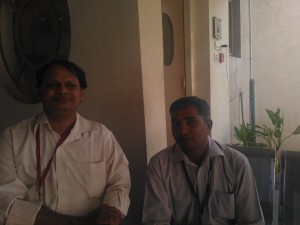
CAS No.......518048-05-0 (free acid)
871038-72-1 (monopotassium salt)IUPAC Name:- N-(2-(4-(4-fluorobenzylcarbamoyl)-5-hydroxy-1-methyl-6-oxo-1,6-dihydropyrimidin-2-yl)propan-2-yl)
Organic Process Research and Development, 2011 , vol. 15, 1 pg. 73 - 83,
143 - 144.1 °C(free acid)
MW: 444.42
..........................................................
K SALT
C20H20FN6O5*K, 482.513
MP..275 - 277 °C
European Journal of Medicinal Chemistry, 2012 , vol. 50, pG. 361 - 369
Drug information:- Raltegravir is an Anti-microbial drug further classified as anti-viral agent of the class integrase inhibitor. It is used either signally or in combination with other drugs for the treatment of human immunodeficiency virus (HIV) and further clinical trials are in process.
RALTEGRAVIR
CAS NO. 518048-05-0, Raltegravir H-NMR spectral analysis
k salt
............
http://www.google.com/patents/WO2011123754A1?cl=en
Raltegravir, also referred to as Raltegravir free hydroxy, N-(2-(4-(4- fluorobenzylcarbamoyl)-5 -hydroxy- 1 -methyl-6-oxo- 1 , 6-dihydropyrimidin-2-yl)propan-2- yl) -5-methyl-l,3,4-oxadiazole-2-carboxamide, having the following formula;
is an antiretroviral drug used to treat HIV infection. Raltegravir targets integrase, an HIV enzyme that integrates the viral genetic material into human chromosomes, a critical step in the pathogenesis of HIV. Raltegravir potassium salt is marketed under the trade name ISENTRESS™ by Merck & Co.
Raltegravir and its preparation are described in US Patent No. 7,169,780. US Publication No. US 2006/0122205, WO 2010/140156 and WO 2011/024192 describe potassium salt of Raltegravir including amorphous and crystalline forms I, II, III and HI as well as amorphous and crystalline forms of Raltegravir free-hydroxy. The present invention relates to salts of Raltegravir, as well as solid state forms of Raltegravir and Raltegravir salts. These properties can be influenced by controlling the conditions under which Raltegravir potassium, Raltegravir sodium, Raltegravir calcium, Raltegravir tert-butyl amine, Raltegravir lithium, Raltegravir diethylamine, Raltegravir diisopropylamine, Raltegravir meglumine and Raltegravir free hydroxy, are obtained in solid form.
Polymorphism, the occurrence of different crystal forms, is a property of some molecules and molecular complexes. A single molecule may give rise to a variety of polymorphs having distinct crystal structures and physical properties like melting point, thermal behaviors (e.g. measured by thermogravimetric analysis - "TGA", or differential scanning calorimetry - "DSC"), X-ray diffraction pattern, infrared absorption fingerprint, and solid state NMR spectrum. One or more of these techniques may be used to distinguish different polymorphic forms of a compound.
http://www.google.com/patents/WO2012103105A1?cl=en
U.S. Patent No. 7, 169,780 discloses Raltegravir and preparation thereof, as described in the following reaction scheme:
Scheme 1
J. Med. Chem. 2008, 51 , 5843-5855 discloses another process for preparing Raltegravir as described in the following reaction scheme:
RLT K-salt
Scheme 2 U.S. Publication No. US 2006/0122205 describes an alternative process for preparing Raltegravir, in which the alkylation step does not include a step for protecting the 5-hydroxy group. The process is described in the following reaction scheme:
Scheme 3
Provided herein is an industrially applicable process for preparing RLT-7', RLT-8, RLT-9 and RLT-9-OP, intermediates in the synthesis of Raltegravir, as well as processes for preparing Raltegravir and crystalline forms thereof.
US Publication No. US 2006/0122205, WO 2010/1401 56 and WO 201 1 /
024192 describe the potassium salt of Raltegravir, including amorphous and crystalline forms I, II, III and H I , as well as amorphous and crystalline forms of Raltegravir free- hydroxy. PCT publication No. WO 201 1/123754 describes certain Raltegravir salts and polymorphs, including form V of Raltegravir potassium.
Example 9: Preparation of Raltegravir
To a 0.5 liter reactor was added acetonitrile ( 15 vol), N-methylpyrrolidinone ( 1 vol) and N-methylmorpholine (0.5 g). The resulting solution was cooled to about 0°C and then methyl oxadiazole- potassium (8g) was added. Pivaloyl chloride (7.22 ml) was then added dropwise (over 10 min). The resulting mixture was stirred for about 6 h.
N-Methylmorpholine (5.9 g) and RLT-9 were then added. The resulting mixture was then heated to 20°C and stirred for 16h. The solvent was then evaporated to provide a residue. Water (75 ml) and isopropyl alcohol (25 ml) were added to the residue. The resulting solution was stirred overnight at RT. A precipitate formed and was filtered and washed with water (10 ml) and IPA (20 ml). The product was dried under vacuum at 60°C overnight to give 8.76g Raltegravir (85.7% assay, 77% yield). The obtained crude product was purified by slurry in MeOH/Water mixture
https://web.stlawu.edu/library/system/files/course_readings/Discovery%20of%20Raltegravir,%20a%20Potent,%20Selective%20Orally%20Bioavailable.pdf
Journal of Medicinal Chemistry, 2008, Vol.51 no 18 pg 5854
free base
NMR (DMSO-d6)δ
12.19 (s, 1 H), 9.83 (s, 1 H), 9.25-8.90 (bs,1 H), 7.39 (dd,J)8.5, 5.6 Hz, 2 H), 7.16 (app. t,J)8.8 Hz, 2H), 4.51 (d,J)6.4 Hz, 2 H), 3.48 (s, 3 H), 2.56 (s, 3 H), 1.74 (s,6 H). MSm/z445 (M+H)+. HRMS calcd for C20H22O5N6F(M+H)+
: 445.16302. Found: 445.16278. Melting point 216°C.
k salt
1H NMR (DMSO-d6) 11.70-11.20 (bs, 1 H), 9.75 (s, 1H), 7.33 (dd,J)8.8, 5.8 Hz, 2 H), 7.12 (app. t,J)
8.8 Hz, 2 H),4.44 (d,J)5.8 Hz, 2 H), 3.40 (s, 3 H), 2.56 (s, 3 H), 1.70 (s, 6H). Melting point 282°C
..............................................
nmr
Imp roved synthesis of raltegravir
GUO D i2liang et al
Department ofM edicinal Chem istry, China PharmaceuticalUniversity, N anjing 210009;
Journal of China Pharmaceutical University 2009, 40 (4) : 297 - 301
http://star.sgst.cn/upload/attach/attach20091230100028d4masjzgcv.pdf

1H NMR (CD3OD) δ: 7.40 (m, 2H) , 7.04 (m , 2H) ,
4.56 (s, 2H ) , 3.46 ( s, 3H ) , 2.65 (s, 3H ) , 1.83 (s,
6H);
13C NMR (CD3OD ) δ: 168.4, 164.8, 163.2,
162.0, 161.9, 160.1, 155.3, 145.8, 136.0, 134.9,
131.0, 116.7, 116.6, 60.2, 43.8, 41.3, 34.8, 27.6,
11.4;
ESI2MS m /z 443 (M )-; LR2MS (EI) m /z 444(M )+; HR2MS ( E I) m /z C20 H21 FN6O5(M )+
calcd444, 155, 7, found 444, 154, 2
second set
WO2009088729 , US20100280244
lH NMR (399.87 MHz5 CDCI3) δ 12.04 (s, IH), 8.45 (s, IH), 7.94 (t, J = 6.2 Hz, IH), 7.41-736 (m, 2H), 7.08-7.02 (m, 2H)5 4.61 (d, J - 6.2 Hz, 2H), 3.68 (s, 3H), 2.63 (s, 3H), 1.87 (s, 6H).
13C NMR (100.55 MHz, CDCI3) δ 168.3, 166.7, 162.6 (d, JCF=245.7 Hz), 159.6, 159.1, 152.O5 150.4, 147.2, 133.4 (d, JCP=3.2 Hz)5 129.9 (d, JcF=8.0 Hz), 124.1, 115.9 (d, JcF=21.7 Hz), 58.0, 42.7, 33.5, 26.7, 11.4.
.........................
IR
WO2011024192, WO2011024192A3
absorption bandsKBR (cm"1) at 832, 1017, 1248, 1350, 1510, 1682, 2995, and 3374
...................
K SALT
Org. Process Res. Dev., 2011, 15 (1), pp 73–83
DOI: 10.1021/op100257r
http://pubs.acs.org/doi/full/10.1021/op100257rmp 274.2−275.2 °C. 1H NMR (500 MHz, DMSO-d6) δ: 11.65 (t, J = 6.0 Hz, 1 H), 9.75 (s, 1 H), 7.36 (dd, J = 8.6, 5.7 Hz, 2 H), 7.14 (app. t, J = 8.6 Hz, 2 H), 4.48 (d, J = 6.0 Hz, 2 H), 3.43 (s, 3 H), 2.58 (s, 3 H), 1.73 (s, 6 H);
13C NMR (125 MHz, DMSO-d6) δ: 168.7, 167.0, 166.6, 162.1 (d, JCF = 243 Hz), 159.7, 158.3, 153.1, 139.6, 138.0 (d, JCF = 3 Hz), 130.2 (d, JCF = 8 Hz), 123.7, 116.0 (d, JCF = 22), 58.4, 42.1, 33.3, 28.1 (2 C), 11.7.
.................................
.........
China Pharmaceutical University (CPU), located in the "ancient capital city of six dynasties" - Nanjing, is one of the "211 project" key universities ...
DHAKA BANGLADESH
Steamers and ferries in Sadarghat Port
 .
.




